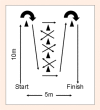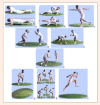Suitability of FIFA's "The 11" Training Programme for Young Football Players - Impact on Physical Performance
- PMID: 24149898
- PMCID: PMC3761904
Suitability of FIFA's "The 11" Training Programme for Young Football Players - Impact on Physical Performance
Abstract
There is a paucity of evidence regarding the use of injury prevention programmes for preadolescents participating in sport. "The 11 "injury prevention programme was developed by FIFA's medical research centre (F-MARC) to help reduce the risk of injury in football players aged 14 years and over. The aim of this study was to determine the suitability and effectiveness of "The 11 "for younger football players. Twenty-four [12 experimental (EXP), 12 control (CON)] young football players (age 10.4 ± 1.4 yr) participated. The EXP group followed "The 11 "training programme 5 days per week, for 6 weeks, completing all but one of the 10 exercises. Prior to, and after the intervention, both EXP and CON groups performed a battery of football-specific physical tests. Changes in performance scores within each group were compared using independent t-tests (p ≤ 0.05). Feedback was also gathered on the young players' perceptions of "The 11". No injuries occurred during the study in either group. Compliance to the intervention was 72%. Measures of leg power (3 step jump and counter-movement jump) increased significantly (3.4 and 6.0% respectively, p < 0.05). Speed over 20 m improved by 2% (p < 0.05). Most players considered "The 11 "beneficial but not enjoyable in the prescribed format. Given the observed improvements in the physical abilities and the perceived benefits of "The 11", it would appear that a modified version of the programme is appropriate and should be included in the training of young football players, for both physical development and potential injury prevention purposes, as well as to promote fair play. To further engage young football players in such a programme, some modification to "The 11 "should be considered. Key pointsChildren who participate in recreational and competitive sports, especially football, are susceptible to injury.There is a need for the design and assessment of injury prevention programmes for children.The 11 "improves essential physical performance characteristics and has the potential to reduce the risk of injury.It may be prudent to implement a 'child-friendly' version of "The 11", to enhance long-term programme adherence and to ensure progressive physical development of players.
Keywords: FIFA; Injury; children; football; prevention; soccer.
Figures
Similar articles
-
The effect of short period high-intensity circuit training-modified FIFA 11+ program on physical fitness among young football players.J Sports Med Phys Fitness. 2020 Jan;60(1):11-16. doi: 10.23736/S0022-4707.19.09813-X. Epub 2019 Sep 23. J Sports Med Phys Fitness. 2020. PMID: 31565913
-
High adherence to a neuromuscular injury prevention programme (FIFA 11+) improves functional balance and reduces injury risk in Canadian youth female football players: a cluster randomised trial.Br J Sports Med. 2013 Aug;47(12):794-802. doi: 10.1136/bjsports-2012-091886. Epub 2013 Apr 4. Br J Sports Med. 2013. PMID: 23559666 Clinical Trial.
-
Efficacy of the FIFA 11+ Warm-Up Programme in Male Youth Football: A Cluster Randomised Controlled Trial.J Sports Sci Med. 2014 May 1;13(2):321-8. eCollection 2014 May. J Sports Sci Med. 2014. PMID: 24790486 Free PMC article.
-
FIFA 11+: an effective programme to prevent football injuries in various player groups worldwide-a narrative review.Br J Sports Med. 2015 May;49(9):577-9. doi: 10.1136/bjsports-2015-094765. Br J Sports Med. 2015. PMID: 25878073 Free PMC article. Review.
-
Football injuries in children and adolescent players: are there clues for prevention?Sports Med. 2013 Sep;43(9):819-37. doi: 10.1007/s40279-013-0061-x. Sports Med. 2013. PMID: 23723046 Review.
Cited by
-
The reach and adoption of a coach-led exercise training programme in community football.Br J Sports Med. 2014 Apr;48(8):718-23. doi: 10.1136/bjsports-2012-091797. Epub 2013 Mar 12. Br J Sports Med. 2014. PMID: 23482922 Free PMC article. Clinical Trial.
-
"Yeah, I Mean, You're Going to Handball, so You Want to Use Balls as Much as Possible at Training": End-Users' Perspectives of Injury Prevention Training for Youth Handball Players.Int J Environ Res Public Health. 2022 Mar 14;19(6):3402. doi: 10.3390/ijerph19063402. Int J Environ Res Public Health. 2022. PMID: 35329089 Free PMC article.
-
A 10-week FIFA 11+ program improves the short-sprint and modified agility T-test performance in elite seven-a-side soccer players.Front Physiol. 2023 Nov 30;14:1236223. doi: 10.3389/fphys.2023.1236223. eCollection 2023. Front Physiol. 2023. PMID: 38098808 Free PMC article.
-
Training Effects of the FIFA 11+ Kids on Physical Performance in Youth Football Players: A Randomized Control Trial.Front Pediatr. 2018 Mar 5;6:40. doi: 10.3389/fped.2018.00040. eCollection 2018. Front Pediatr. 2018. PMID: 29556489 Free PMC article.
-
Injury prevention exercise programmes in professional youth soccer: understanding the perceptions of programme deliverers.BMJ Open Sport Exerc Med. 2016 Jan 4;2(1):e000075. doi: 10.1136/bmjsem-2015-000075. eCollection 2016. BMJ Open Sport Exerc Med. 2016. PMID: 27900158 Free PMC article.
References
-
- Arnason A., Andersen T.E., Holme I., Engebretsen L., Bahr R. (2008) Prevention of hamstring strains in elite soccer: an intervention study. Scandanavian Journal of Medicine and Science in Sports 18, 40-48 - PubMed
-
- Berbig R. (1997) Die Verletzungsgefährdung im Spitzenfuβball aus der Sicht des Sporttraumatologen. Schweizer Zeitschrift für Sportmedizin und Sporttraumatologie 45, 127-130 In German
-
- Blaser K.U., Aeschlimann A. (1992) Unfallverletzungen beim Fuβball. Schweizer Zeitschrift für Sportmedizin 40, 7-11 - PubMed
-
- Caraffa A., Cerulli G., Projetti M., Aisa G., Rizzo A. (1996) Prevention of anterior cruciate ligament injuries in soccer. A prospective controlled study of proprioceptive training." Knee Surgery Sports Traumatology Arthroscopy 4, 19-21 - PubMed
LinkOut - more resources
Full Text Sources


